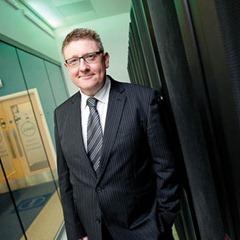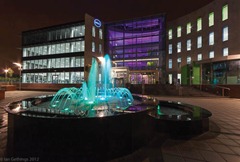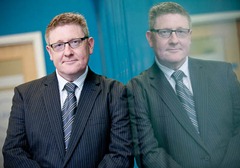Open systems drive change
 Dell’s General Manager in Ireland, Liam Halpin, discusses the changing nature of the IT giant’s business and the industry in general, with cloud becoming normal but security more important than ever. A diverse workforce is giving Dell Ireland a real edge in its EMEA area of operations.
Dell’s General Manager in Ireland, Liam Halpin, discusses the changing nature of the IT giant’s business and the industry in general, with cloud becoming normal but security more important than ever. A diverse workforce is giving Dell Ireland a real edge in its EMEA area of operations.
As Liam Halpin relates, Ireland stands out as a significant location for Dell for a number of reasons. It’s firstly the sixth largest market in Europe with the company holding a significant share of PC and laptop sales. “We’ve also over 52 per cent of the mainstream market share in servers,” Liam Halpin comments. “We’re the leading provider of storage in the country as well, shipping the largest volume of terabytes. When you combine that with our capability around software and services, which are lesser known,” Dell has 2,300 employees in Ireland, across campuses in Dublin, Cork and Limerick. The decision to downsize the Limerick operation is well-known but around 800 staff still work there in its Europe, Middle East and Africa solutions centre. Its remit includes application development, proof of concepts with customers and an industry solutions lab. The latter has involved working with companies such as Tobii which manufactures systems to allow people to operate tablets, laptops or computers with their eye movements.
“For someone who’s quadriplegic or paraplegic that’s a fantastic capability,” Halpin remarks. “We also work on a number of healthcare and educational solutions as well. We’re pretty big in those sectors. In addition to solutions, we also do technical or enterprise support.”
Dell’s Dublin campus has a 24/7/365 workcycle and provides leading data centre, virtualisation and cloud networks across the Middle East and Africa. It’s also a hub for EMEA global marketing, talent and diversity management, and Dell Bank International – an Irish commercial bank which represents an investment by Dell of over $500 million to offer technology-connected financial solutions in Ireland and 14 other EU member states – with another three countries due to be added in the coming months.”
Dell Ireland is therefore one of the company’s largest sites outside the continental USA. The Cork campus has 200 employees working on Dell software following an acquisition that began 18 months ago and it’s now the EMEA headquarters for Dell Software.
In addition to the obvious employment benefits there are wider community gains. “From a community perspective, we do a lot of events sponsorship,” Halpin adds. “We run a programme of community giving where if an employee donates 10 hours of their own time on a quarterly basis, the company will give them $150 towards a group of their own choice.” Community giving can be for a football team and charitable work. Dell has also been the corporate sponsor for the Irish Cancer Society’s Daffodil Day over the last five years and its corporate headquarters lights up in yellow each year.
The company helped to deliver last year’s Special Olympics in Limerick where its staff won a corporate social responsibility award from the city’s chamber of commerce. Dell also runs a project and programme management course for charitable organisations: “That’s something that we as a company facilitate but the staff give their own time. It’s been hugely successful and we’ve had close to 70 charities through our doors in the last 12 months.”
Halpin finds that the best type of CSR is driven by the employees. At an EMEA level, Dell staff gave 100,000 hours of voluntary work every quarter and participation rates in Ireland are among the highest: “We’ve some very inventive and artistic people who work for us.”
Government
Dell has been a strong provider of products and services into government – whether at a central, local or agency level – and its dedicated team focuses on those accounts i.e. a mixture of account managers and technical specialists. Dell Ireland also has an all-island remit, taking in a myriad of services.
“We’ve been pretty strong on the government part of our business,” he affirms. In terms of change in recent years, he adds: “There are a lot more frameworks and connected-up thinking from a government perspective.”
Government CIO Michael McGrath has announced the buy-to-share tender which has received a very strong response. The general trend is that changes in government ICT appear in the USA several years before they take effect in Europe.
 “From a government perspective, the challenge is that you can’t just go out and use public cloud services like everybody else,” Halpin notes. “There’s a higher level of expectation when it comes to data and data security vis-à-vis where those data are located.” Other governments, notably the USA, have taken the building blocks of public cloud and created private clouds that deliver elasticity, flexibility and the cost base in the network.
“From a government perspective, the challenge is that you can’t just go out and use public cloud services like everybody else,” Halpin notes. “There’s a higher level of expectation when it comes to data and data security vis-à-vis where those data are located.” Other governments, notably the USA, have taken the building blocks of public cloud and created private clouds that deliver elasticity, flexibility and the cost base in the network.
He sees government strategy evolving in the same way in Ireland but he also cautions against creating any ‘vendor lock-in’ whereby a decision limits the contract to a particular vendor or technology. Halpin explains: “Everything which we sell, whether it’s our storage systems or server systems, is all open. Our console management system is able to manage other vendors as well as our own. If the customer has a requirement that they need somebody else’s building for a particular service, we’re quite open in terms of how to integrate.”
Clients sometimes have to make a decision regarding mainframes and middleware purchased in the 1980s and 1990s which are now an impediment to growing and scaling up the business. “It isn’t a phenomenon that’s unique to a government department,” he points out. “We see the same thing happening in banks, insurance companies and other organisations that rely on that type of technology. The main driver that’s creating stress in the system is that there’s an increasing demand from the consumer and the citizen for online transactions and more accessibility for their information.”
Halpin cannot recall the last time he visited his bank branch and 90 per cent of his own interactions with the bank are online. Increasing change in this area will result in a greater requirement for government to provide scalable and flexible systems – with security being the most important factor.
Public sector clients report that data protection legislation is their greatest IT challenge. “Government departments can’t seamlessly share information because of the way that legislation is structured,” he affirms. “It was never envisaged that ‘department A’ should share information with ‘department B’ and there’s a lot of fear in certain sectors where people are reluctant to give their PPS number.”
That said, most people give their bank account, PPS number and other personal details when they are signing up for a new internet or mobile phone service. Halpin would like to see the PPS number becoming like the US social security number i.e. the activator to access all available government services.
Asked how Dell gains an advantage in an open system, he points out that the company highlights its commitment to openness and transparency. Software-defined networking and storage is a significant area where many companies can save money irrespective of the vendor. Having a single supplier limits the client to one particular functionality. Dell sells systems with a Force 10 operating system – developed by an acquired company – which helps to switch hardware systems at exactly the same time in an open standard such as Cumulus.
“Our storage runs on servers with a lot of disc,” he adds. “When you buy Dell Storage, you have all the licensing for all of the functionality from day one. With a lot of our competitors, when you retire the hardware and bring in new hardware, you’re really buying the software again.”
While the company would “very much like” customers to be 100 per cent Dell end-to-end, it does not expect this to be the case: “We recognise that in most customer scenarios, there’s going to be a requirement for using other people’s systems. We want to be flexible and we don’t want to create those lock-ins.” One of the challenges is that customers which are using to lock-in arrangements for software often do not recognise that Dell’s offer comes with “no strings attached”.
Halpin says that Ireland has become “an extremely interesting county” in the last 20-25 years, having evolved from an agriculturally-based economy to “the closest thing to Silicon Valley outside Silicon Valley.” Halpin adds: “The Government has managed to create a business-friendly, accessible environment that now facilitates organisations that are looking to deliver jobs.”
The company takes a broad view of job creation, with 68 nationalities operating out of its building in Dublin e.g. supporting enterprise systems in the UK and Ireland and also as far away as Kazakhstan or Saudi Arabia. “If we didn’t have the 67 other nationalities here,” he comments, “this facility wouldn’t be as important. It’s not about us learning the languages. It’s about us having a diverse workplace and a flexibility around bringing people to the country to enhance the value that’s already here.”
Halpin acknowledges that some inward investors are here for tax purposes but Dell’s number one internal conversation about expanding its business here is about talent and flexibility.
“Irish people are great for rolling their sleeves up and getting stuck in but when you go to some other countries that’s not as prevalent and it’s not easy to change jobs and it’s not easy to get things done.” Ireland is a great place for setting up a business and it’s not hard to convince its colleagues abroad in terms of the need to take care of the cost base. The conversation is multi-faceted because of the need to be competitive in labour rates but also the need to make sure that the country is competitive to work in.
Ireland needs to be an attractive place in which to work for individuals as well as an attractive location for investment in tax terms. Halpin therefore welcomes the streamlining of the work permit system over the last three years which facilitates multi-lingual capability.
Future
Looking ahead, he notes that security and digital reputation are two of the most important issues for individuals and corporate entities. Reputation can be ruined very quickly and hacking has moved from being a nuisance – “digital graffiti” – to criminal enterprises targeting organisations to extort money from them or to steal and sell on personal details.
In some cases, an organisation’s infrastructure has been hijacked, encrypted and ransomed back to it.
A ‘cyber-war’ is also taking place with corporate organisations targeting their competitors’ intellectual property and nation-states doing the same for political purposes.
Mobility is “just going to keep going”. Ten years ago, a typical home’s IP-enabled devices were the laptop, PC and wireless router. As mobility evolved, the Xbox and PlayStation joined that list and now mobiles, fridges and cookers are IP-enabled as well. When this trend is linked into the ‘internet of things’, wearable technology and the proliferation of mobile devices, it will be put more pressure on governments and businesses.
The greatest opportunity, in his view, is in data analytics where predictive data can help the patient to see what is going wrong before their condition worsens. Governments can therefore tap into wearable technology with a greater ability to predict reducing cost in the health system.
Companies no longer buy a bespoke CRM system but instead opt for Microsoft Dynamics or www.salesforce.com
In conclusion, to use one Irish example, Mark O’Dwyer’s Big Red Book Company is now a cloud service whereas it began in the 1990s as a software package on disc. “Cloud is just normal now,” Halpin surmises, “and those are the key areas that we see as driving most of the trends that are happening.”
Profile: Liam Halpin
Born on the Curragh Camp, Liam had been due to study computer science at Carlow IT but successfully wrote and launched two video games at the aged of sixteen in 1983. He completed his Leaving Cert three years later and then studied part-time at the College of Commerce whilst working in retail.
He then subsequently worked in Germany, selling cars to US military personnel, and returned in Ireland in 1991 for family reasons. Posts in Canon, Fujitsu, Siemens and PFH Technology followed over the next 20 years. Liam joined Dell in 2011, initially being responsible for large enterprise sales in the UK before moving to the GM post two years ago.
He’s married with five children, two dogs, three cats and a goldfish. Interests outside work include self-build computing and cycling with Naas Cycling Club – 4,000km last year with the aim of completing 6,000km this year.






